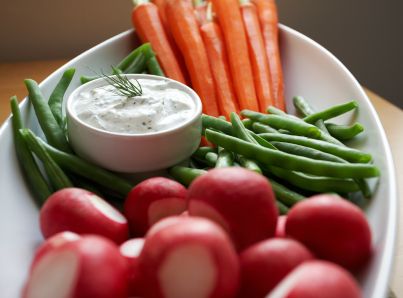|
I love to accessorize, don't you? A hat, scarf or belt can make or break an outfit, just as a sauce, dressing, or marinade can make or break a dish. Like everything else in my life, it all circles back to food--even accessories. For me, the perfect accessory for salads, cold meats, fruit plates, and even savory dishes is the dressing. It can be spicy, herbal, creamy, served hot or cold. I love them all. The trouble is that traditional recipes call for loads of fat in the form of oils or cream. When you're cutting the fat in dressings, the trick that I have found is that the flavor has to come in with a loud punch to offset the smaller amount of oils and cream. "Dressing" is a vague term that can be used to describe vinaigrettes, dipping sauces, marinades, and even flavored oils. Whatever you call them, they basically can be divided into two categories: vinaigrettes and creamy dressings. Vinaigrette is a simple emulsified* sauce and can be a plain as a 3: 1 ratio of vinegar to oil. That sounds a little boring--and heavy. I like to reduce the ratio of oil and add some other ingredients from my pantry. Dijon Mustard, grated carrots, chopped herbs, garlic, and pureed vegetables all add flavor and help the oil and vinegar stay nicely mixed. For a basic but tasty vinaigrette that will accessorize shredded kale, spinach, or even a serving of grilled chicken, try my Garlic Dijon Vinaigrette. *Chef's Tip: Emulsify means to combine two ingredients that don’t like to stay mixed, such as oil and vinegar. Is creamy more your fancy? While traditionally made with gobs of mayo and sour cream, creamy dressing can be made without them. Greek yogurt or non-fat plain yogurt do a nice job as stand-ins. I love the Greek yogurt because of the creamy texture and thickness. (If you don't eat dairy, try soft tofu.) Adding fresh herbs infuses the base of yogurt with color and provides a cooling taste. For spring, try my Creamy Fat Free Herb Dressing.  If you are looking for some extra heat, try adding a spice blend to a yogurt base. To 6 ounces of Greek yogurt, add 1 tablespoon of my Creole Spice Blend and you'll have a dipping sauce for pork, beef or chicken. You can also use it as a sandwich spread. (Not a fan of Creole spices? Experiment with what you already have on hand. You will use up your purchased spices and seasonings before they go stale and save money at the same time.) Tips to make the perfect dressing:
Want more salad dressing recipes? Try the dressings from these recipes: Escarole Salad with Gorgonzola-Walnut Apple Crisps Grapefruit Salad Carrot-Cranberry Salad Pomegranate Chicken Salad Roasted Beet Salad Or try one of these recipes for easy, homemade salad dressings. Want more healthy recipes from me and fellow SparkPeople members? Be sure to subscribe to SparkPeople's Recipe of the Day email. Click here to sign up! Did you know SparkRecipes is now on Facebook? Click here to "Like" us! Like this recipe? Then you'll love "The SparkPeople Cookbook: Love Your Food, Lose the Weight." |
Related Entries
More From SparkPeople
|



.jpg)



.jpg)

.jpg)
.jpg)












